Why we ran it: To see if the Volkswagen ID 4 GTX, the performance version of the firm's all-electric SUV, lived up to its grand touring aspirations
Month 6 - Month 5 - Month 4 - Month 3 - Month 2 - Month 1 - Specs
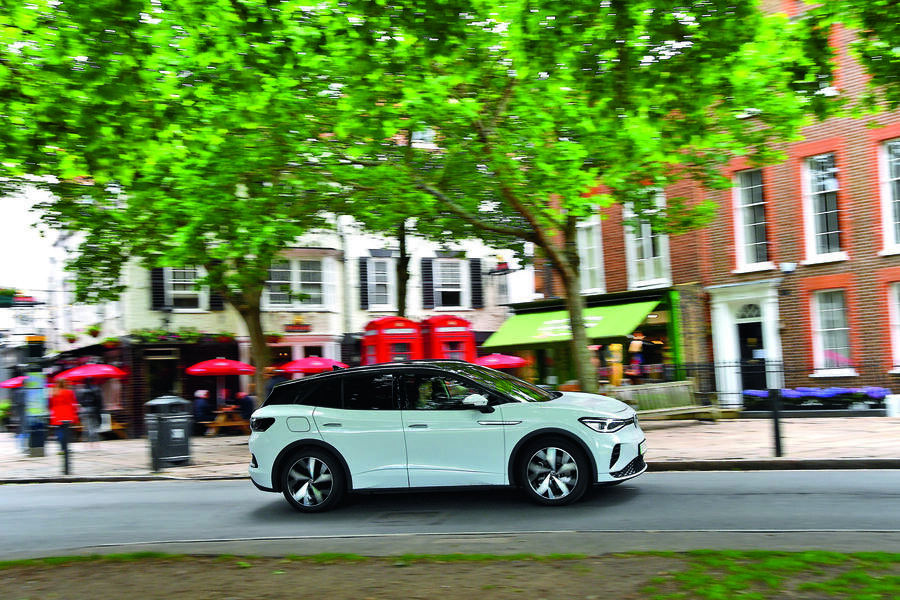
This new style of performance EV had more than 12,000 miles to get under our skin and win us over. Did it succeed? - 30 November
Saying goodbye to the ID 4 GTX after more than 12,000 miles was bittersweet. In my quest to discover what a ‘GTX’ truly is - and to see if an electric SUV could hold up as a long-distance grand tourer, there were moments of glee and moments of frustration.
For me, the best thing about this performance SUV was its powertrain - 294bhp is not to be sniffed at, and a hot-hatch rivalling 0-62mph time of 6.2sec felt exceptionally brisk in a car of the ID 4’s size and weight. Each burst of instantly delivered power, I was left feeling satisfied and confident that I could overtake most other cars on the road with ease.
In fact, the ID 4 GTX showed several ‘grand tourer’ qualities over those six months. Its ride was comfortable over long distances on a wide variety of roads. It was brilliantly practical as well, suitable for holidays and extensive shopping trips. The range was largely usable, but still, of course, worlds away from virtually all petrol or diesel offerings.
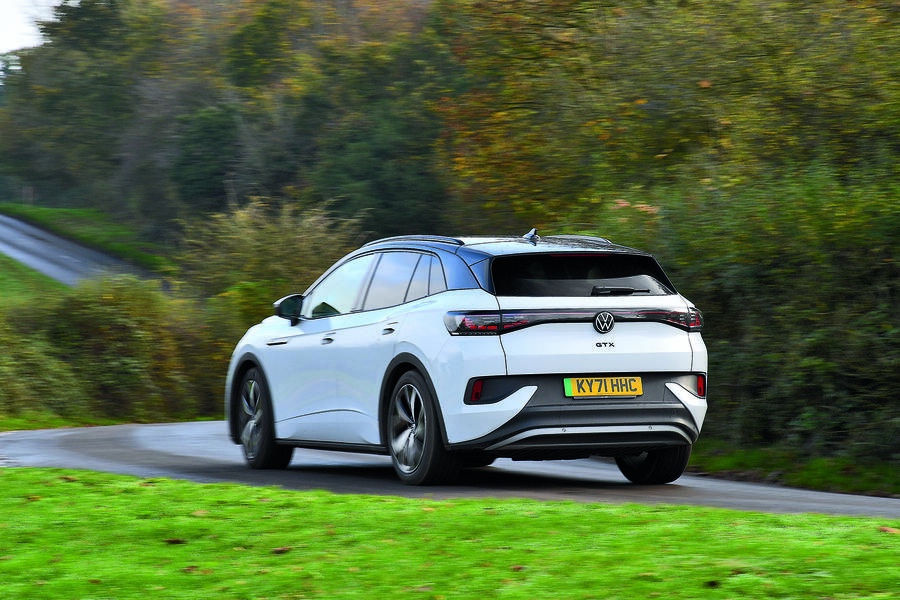
It was good in both warm and cooler temperatures. I would routinely wake up to between 245 and 265 miles of range, which increased to around 275 miles in the warmest summer periods. The highest range figure I managed was 282 miles, which is just shy of Volkswagen’s advertised 299 miles. But my journeys were no longer than 250 miles with several planned stops along the way, so that worked well for me and chomped up my 150-mile round commute.
But one piece of advice: if you’re getting an ID 4 GTX, you simply must go for the heat pump - a £1050 option, which sounds expensive but offers significant, noticeable benefits to improve heating inside the cabin, reducing energy consumption by 40% when doing so. I drove an ID 5 that did not have this option fitted and the range savings when using the air con were clear as day. While it does have a noticeable, audible whir, it’s well worth it.
Life with the ID 4 also had its less positive moments. Grand tourers, which Volkswagen says the GTX is meant to represent with all-wheel drive, more power and performance, are supposed to offer a relaxing environment - somewhere to chill out and enjoy the ride - when you’re not foot-to-the-floor and burning rubber at the lights.
This is where the ID 4 lost a few marks, led by problems caused in part by the model’s software. As I’ve documented several painstaking times over the last few months in these reports, I was often left frustrated with driving because of various bugs, issues and inconsistencies with the model’s in-car entertainment and assistance kit.
The infotainment is a good case in point. It has all the things an EV would make good use of, be it in-built charging navigation, Apple CarPlay and sat-nav, but my experience showed that the system itself was so unresponsive that I would go to great lengths to avoid using it entirely.
The same goes for the touchpad interface, which was laggy, distracting and a general pain to use, both for the heating controls and on the steering wheel. The climate control system has been improved in the new Polo, so hopefully we’ll see that when the ID 4 receives a facelift later down the line.
Reports say that boss Thomas Schäfer wants to bring forward the facelift of the smaller ID 3 partly because of the system stability of the current model, so fingers crossed the ID 4 gets the same treatment.
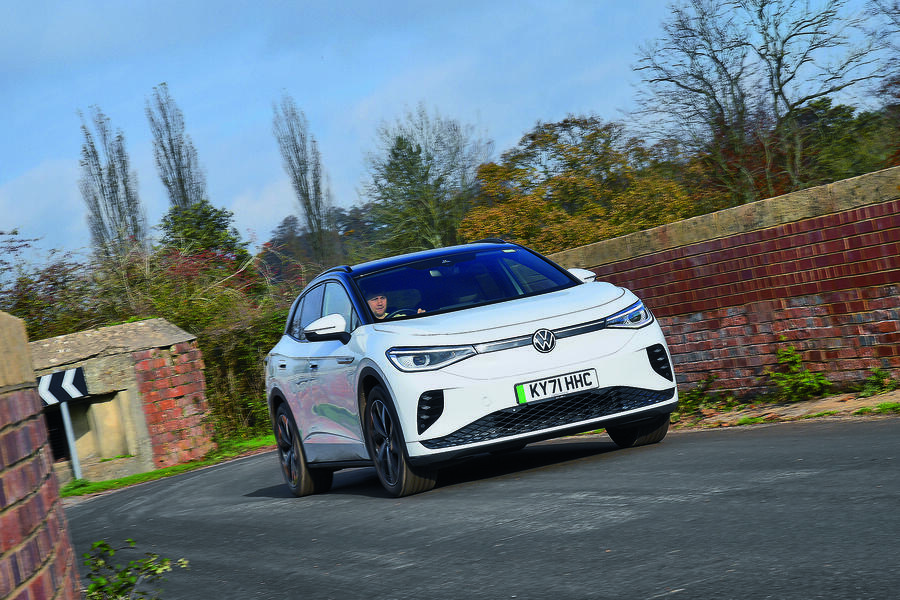
The voice control would also randomly kick off at me for no reason, often interrupting general conversations with passengers in the car, and the song-change touchpad would get stuck in an infinite loop. I am pleased wireless Apple CarPlay was included as standard which, partnered with wireless phone charging, made my long commute far more bearable.
But those negatives never put me off from wanting to drive the ID 4. It’s not the most exciting SUV out there and I always felt the interior wasn’t as special as it should be for the price. I can’t say I woke up every morning bleeding with excitement to get behind the wheel either, but the security and stability provided by the all-wheel drive powertrain meant almost every journey was effortless.
The point remains that I’m still not quite sure what a GTX is. Having spent time with a non-performance ID 5 with which the ID 4 shares its powertrain selection, I’m also not so sure those three letters will be enough to convince buyers to make the near-£10,000 jump from a well-specced ID 4 Life Edition. In fact, across these six months, I’ve not seen a single other ID 4 GTX on the road.
I think both us, the driver, and Volkswagen will both truly know what a GTX model is when those three letters are attached to the back of an ID 3. There’s some real potential for those performance upgrades and four-wheel drive to offer a game changer for the brand. But first, it needs to get that software in order.
Second Opinion
The jury’s still out on VW’s GTX sub-brand, and when I drove this car at our ‘Fun EV’ group test, it didn’t do much to change that. Smaller, simpler electric cars can be entertaining, but maybe this one’s a bit too big and tall and heavy to do it. Or maybe driving one every day will prove me wrong.
Matt Saunders
Love it:
Range The ID 4’s range was more than enough for me, especially with the luxury of a home charger.
Powertrain It was punchy and performed whenever called on, dispensing sure-footed, accessible pace.
Practicality The ID 4 has a large boot and plenty of room for family and pets, so I was never short on luggage space.
Loathe it:
Touchpads A pain to use. I’d accidentally activate them or press them and they wouldn’t work.
Infotainment Finding things within this system was a long, drawn-out process. The laggy menus were off-putting, too.
Final mileage: 14,664
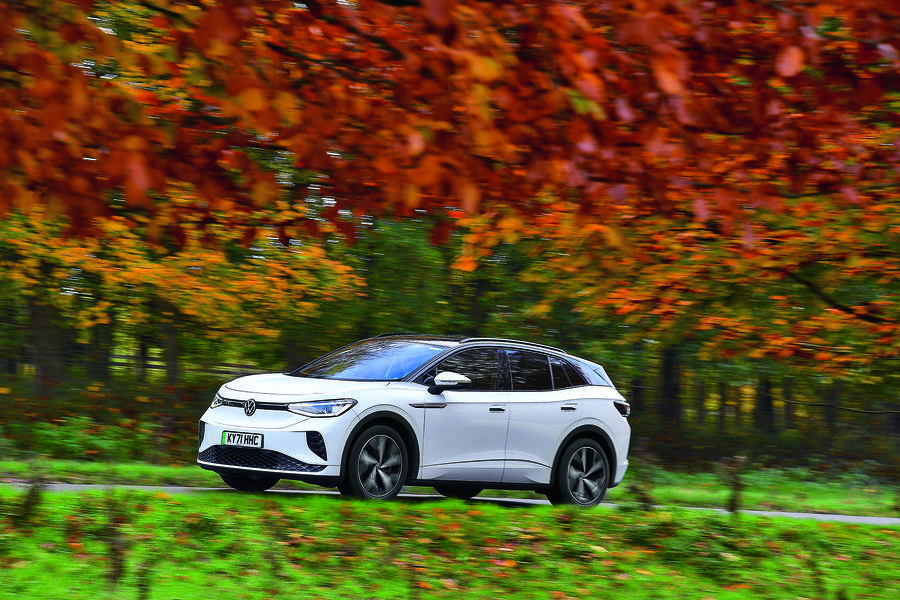
A Polo stands in while our EV is being fixed – and the comparisons prove surprising - 16 November
I mentioned in a previous update that the ID 4 had gone back to Volkswagen because of some loose bodywork, where the plastic surrounding the front near-side wheel arch had come unclipped.
I mentioned in my last log that the ID 4 had been sent back to Volkswagen because of some loose bodywork, where the plastic surrounding the car’s front passenger wheel arch had come unclipped.
It ended up staying at the Volkswagen workshop longer than expected, but it’s not all bad news – it meant I had the opportunity to spend a week in a brand spanking new Volkswagen Polo, in range-topping R-Line specification no less.
The Polo you see pictured here is driven by a 1.0-litre turbocharged engine, producing 110bhp with help from a seven-speed DSG. It’s a hearty little engine, quite obviously lacking the punch of the ID 4 but with a little more character.
But the engine isn’t the only thing I want to talk about in regards to the Polo – what stood out to me was the interior, which is a world away from the ID 4, and not in the ways you might think.
To be honest, the Polo is a much nicer place to be. In R-Line guise, it’s awash with soft-touch materials from the top of the cabin to the bottom, while the in-car tech surpasses the ID 4 quite significantly.
Our car was fitted with the 10.25in digital cockpit pro system, which is customisable, displays music data from Apple CarPlay and plenty of other titbits aside. It’s miles away from the tiny little display you get in all models of the ID range, which I don’t quite understand.
The central infotainment system, Volkswagen’s Discover Media system with sat-nav, is far more responsive, crisp and lag-free compared to the larger, 12in Discover Max system in the ID 4.
And it doesn’t end there – the Polo also has vastly improved climate controls over the ID 4. It’s those zany touchpads once again, but they’re far more responsive and they’re actually back-lit, so they can reliably be used at night.
All of this does come at a bit of a premium, though. With the more powerful engine in this car and a £635 Reef Metallic Blue paint, an R-Line Polo comes in at £25,310 – about the same as today’s entry-level Golf.
Everything just feels much higher quality than in VW’s electric model range, and should that really be the case? The prices for the German car maker’s EVs aren’t exactly ‘affordable’ for many buyers, and I can’t help feeling they should feel a bit more special inside. The Polo has a few physical buttons lying around too, and its steering wheel is jam-packed with them, which is another big plus.
When the ID 4 came back to me at the end of October, I was plunged back into the world of touchpads, much to my disdain. Throughout my experience with the car, there have been countless times where I’ve accidentally touched a button leading to skipping a song I was enjoying, turning up the volume, or even activating the cruise control and voice command system.
One slightly peculiar bug I’ve regularly encountered with the touchpads causes the first second of a song you’re listening to get stuck on a constant loop, almost as if it thinks your finger is still pressed down on the pad. The only way I’ve managed to solve it is to switch to the radio, and back to my own music. Weird.
And after almost six months behind the wheel, I accidentally worked out that these steering wheel touchpads in the ID 4 also have a swipe function (up, or down) for changing songs and adjusting the volume. The more you know.
Thankfully, Volkswagen looks to have learned from its mistakes regarding its user interfaces. Last month, boss Thomas Schäfer said Volkswagen is planning to reintroduce proper, push-button steering wheel controls.
That can only be a good thing for prospective buyers, especially given the change is set to be made as a result of customer feedback. It will, without a doubt, make the ID 4 a much more user-friendly car.
Love it
Performance
The ID 4 has a type of satisfying power delivery that the Polo cannot match.
Loathe it
A non-electrified tailgate
Call me lazy, but having to bend down to reach the boot release is becoming a bit of an annoyance.
Mileage: 12,031
Back off to the VW workshop - 2 November
The ID 4 has returned to VW for another stint in the workshop after some clips holding the plastic wheel-arch trim sheared and detached themselves, despite no physical damage to the exterior of the car. This means I’m spending the next week, at least, in a top-spec R-Line Polo. It’s a nice change both size- and weight-wise.
Mileage: 10,612
Colder mornings are having an effect on the range – but not the cabin comfort - 26 October
Looks like that time of year has crept up on us. One evening this week, I got into the ID 4 for a quick drive home from the gym only to notice that the car’s in-built thermostat read a positively glacial 4deg C. That can mean only one thing: its range is about to plummet.
At least that’s the expectation. A big winter range test conducted by our neighbours at What Car? earlier this year fully charged 10 cars and then drove them in cold conditions at speeds of 50mph and 70mph. The conclusion: drivers should expect around 15-20% fewer miles from an EV in the winter.
The ID 4 wasn’t included in these tests but its Volkswagen Group sibling, the Audi Q4 E-tron 50 Sportback, was. It completed 201 miles and was the test’s least efficient car, finishing with 2.6mpkWh - a 30% shortfall on its official range.
The morning after that post-gym drive, I climbed into my ID 4, with a woolly hat and puffy coat (yes, I’m aware it’s only October), to see the fully charged ID 4 display a modest 223-mile range on the screen in front of me. That’s significantly less than the advertised range of 308 miles – especially given that winter hasn’t fully begun to take hold in the UK.
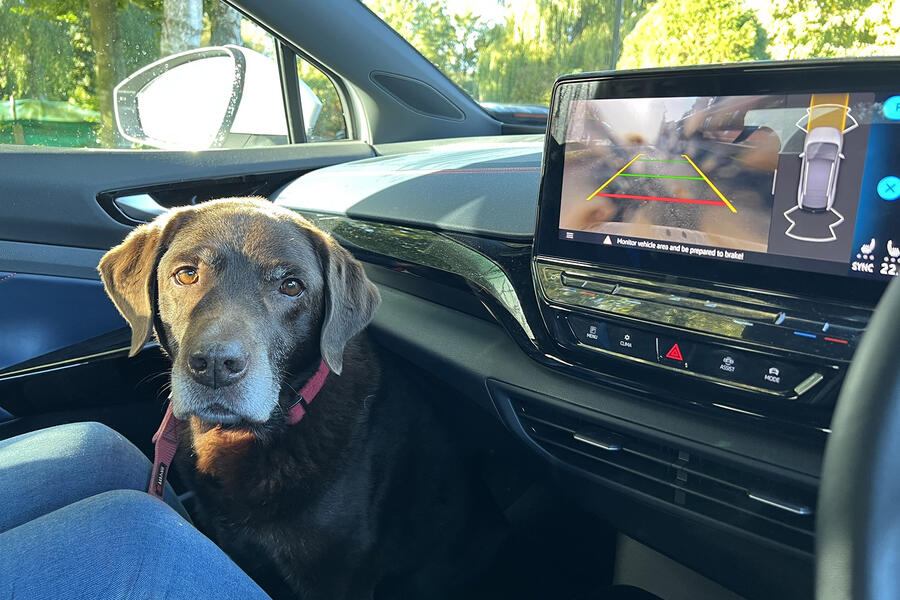
But it’s not such a dramatic drop from the 255 miles that the car has averaged since it first arrived at Autocar. Besides, it was more than enough for my 155-mile commute and I was able to pre-heat the cabin temperature to a toasty 24deg C while the car was still plugged in before setting off.
During this journey, I was far more comfortable in the ID 4 than I’d been in my previous long-term test subject, the Lexus UX 300e. With that car, I spent most of my November-April tenure with the climate control firmly in the ‘off’ position in a bid to eke out the range, almost praying for summer to arrive. (Lexus has just announced a new UX 300e, with a hugely improved range of up to 280 miles, so better late than never.)
In the ID 4, however, I can happily pootle along in comfort on every journey, knowing that I’ll always have enough range to make it home. Volkswagen wants the GTX to be the kind of car that makes you feel relaxed over long distances, and despite the reduced range figure, the ‘grand tourer’ label has now started to make a bit of sense in my mind.
Away from the cold reality of range figures, I found myself testing the ID 4’s credentials as a sort of emergency vehicle. During a walk, my dog happened to step on a wasp, which made her paw swell up and required a quick trip to the vet.
At over 500mm from the ground, the boot was just too high for her to climb into with a foot out of action, and although there’s ample space back there, the sizeable load lip might cause issues for some drivers.
Talking of the boot, it’s worth mentioning that the ID 4 GTX cannot be specified with an electric tailgate, which is available only as part of the Assistance Pack Plus on the range-topping GTX Max specification.
That will disappoint some buyers, given rivals such as the Hyundai Ioniq 5 have a smart, hands-free tailgate as part of their entry-level specification, at a significantly lower price. I often forget my car doesn’t have that option, despite having the button to open the boot on the key fob.
But back to the dog. With the seat pushed all the way back, there was more than enough space for her to comfortably fit in the front without bashing her head on the glovebox.
The ID 4’s good general stability meant she wasn’t thrown around en route. I do wonder how pets cope with the sudden acceleration of EVs, though. Even with a light-footed driving style, the ID 4 can lunge forward suddenly as it picks up speed, so I reckon most pets would be best off in a cage in the boot.
Love it
Home charging
I’m very grateful I’m lucky enough to be able to charge at home. Topping up every day elsewhere would be a major disadvantage.
Loathe it
Steering wheel touchpads
Frustrating to use and not at all responsive. Bring back proper buttons, Volkswagen.
Mileage: 9449
Well packaged or lost practicality? - 12 October
Unlike many other electric cars, the ID 4 doesn’t have any sort of cargo space beneath its bonnet. In fact, there’s so little space that you would be forgiven for thinking there was an actual engine in there somewhere. Meanwhile, its key rival, the Ford Mustang Mach-E, features an 81-litre ‘frunk’. It’s not really an issue for me, though, because the ID 4 is plenty practical as it is.
We’ve been exploring the differences between the five distinct driving modes - 5 October
The ID 4 GTX has an array of driving modes: Eco, Comfort, Traction, Sport and Individual. With that last one, you can loosely customise the weight of the steering, the firmness of the ride and the degree of punch from the powertrain. And having played around with these various settings, I’ve finally landed on my ideal configuration.
Each driving mode has its pros and cons. Eco makes the most of the battery’s remaining charge while sacrificing a bit of power. Sport not surprisingly adds more urgency and more weight to the steering, but it also sticks the regenerative braking up to its maximum setting by default, removing any coasting capability.
Traction is for slippery and loose road surfaces. It improves performance at lower speeds for better stability, and Volkswagen says it activates permanent four-wheel drive at up to speeds of 12mph.
It adjusts the chassis and drive system to the ‘maximum all-wheel drive utilisation’ setting, while the steering and assistance systems go into Comfort mode. Even when it’s not in Traction mode, the ID 4 GTX has excellent all-weather stability, remaining composed even on the wettest roads. But somewhere the setting did come in handy was on a trip to Savernake Forest, near Marlborough in Wiltshire, where you can drive on a dirt and gravel track (with a few steep hills) along the breadth of the woodland.
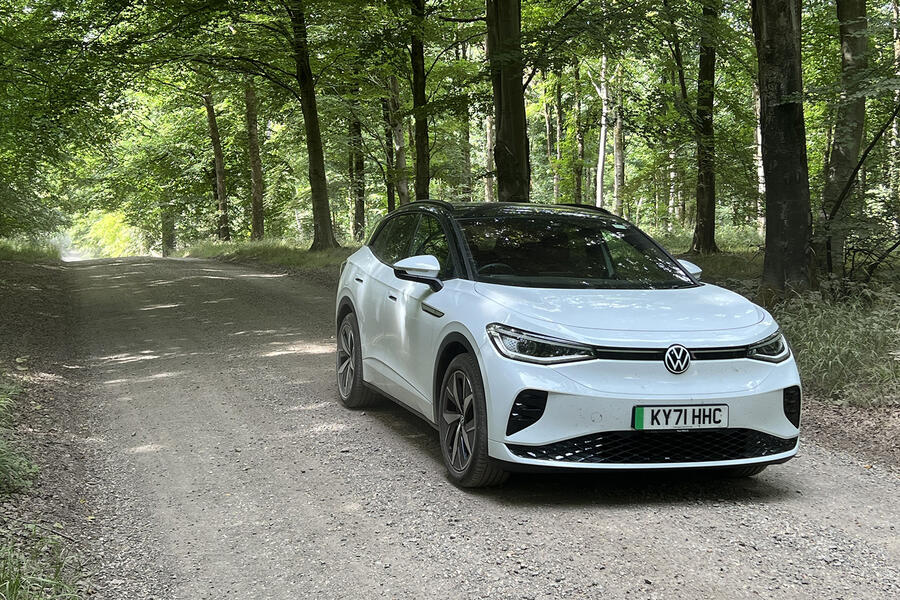
Okay, so it wasn’t quite as extreme as the Dakar or Safari rally, but it at least gave me a chance to try a feature that is likely to be completely ignored by most ID 4 GTX drivers, those who don’t regularly have to navigate muddy tracks or grassy fields.
The car’s stability noticeably improved when accelerating on loose surfaces in Traction mode, but it will be more sternly tested in wintry conditions. Here’s hoping that by some miracle it snows in October so I get the chance to explore its full potential before having to return the car to its maker.
But let’s get back to the road, where I’m keen to highlight a feeling I’ve had since first getting behind the wheel: the ID 4 GTX feels a lot bigger than it actually is. It’s not the largest model VW makes – that being the Touareg, the brand’s combustion-engined luxury SUV – but I still find myself breathing in every time I squeeze past another car on a narrow back road.
The ID 4 GTX is one of those cars that feels far larger than its 4584mm length and 1852mm width would have you believe. Maybe it’s all the flat floor and EV packaging, and its weighty steering. And despite being a quick old thing, the ID 4 GTX feels every kilo of its 2224kg kerb weight. I concur with the findings of our road test team, who concluded at our first-ever EV ‘Handling Day’ that the ID 4 GTX’s chassis fails to deliver as much driver appeal as, say, the Kia EV6 GT or even the closely related Cupra Born (which our fun-hunting judges ranked five places and many more points higher than its VW cousin).
The GTX does sometimes just feel like a faster ID 4, rather than a sportier one in the twisties. Even though the steering and other elements are adjustable, the ID 4 GTX is ultimately lacking in engagement and feel. Whether sporty steering really matters in a grand tourer designed to effortlessly munch motorway miles is, of course, something for buyers to decide.
So it’s no modern, GTI-aping hot hatch, nor is it positioned as an alternative to VW four-wheel-drive sports SUVs like the Tiguan R and Touareg R – but the ID 4 GTX’s urban abilities do strangely remind me of a very different electric stablemate. Despite its size, the ID 4 GTX can be easily manoeuvred through smaller streets and corners. And it manages to spin around in just 10.2 metres – not far off the 9.8m turning circle of the tiny VW e-Up.
Love it
The looks
I’ve not mentioned this before, but I think the ID 4 is actually quite a handsome thing – from the front, at least.
Loathe it
Door handles
My passengers can never find the button under the handles to open the doors, meaning I have to open them from inside every time.
Mileage: 7642
Back to the top
GTX interior doesn't quite cut the mustard - 28 September
The red stitching on the seats, the dashboard and the door cards is a nice touch, but I feel Volkswagen could have done a little bit more to make the GTX stand out from standard ID 4 variants inside. There are a few GTX badges dotted about, but the interior doesn’t look particularly special. It certainly doesn’t scream ‘performance’ at me.
Mileage: 6891
ID 4's mood lighting is relaxing, if cheesy - 14 September
Volkswagen has given its cabin light themes some very cheesy names, but each looks great in action. The blue Desire theme is my go-to, as I find it to be the most calming. I would choose the red Euphoria theme, if it didn’t remind me of the urgency of the IQ Light, which beeps and flashes red when it detects a potential collision.
Mileage: 6422
There’s a good reason you’re staring at an ID 5, not an ID 4, but is our stand-in better? - 7 September
The ID 4 has been called back to Volkswagen’s workshop for a software update. Unfortunately, it’s not the hotly anticipated ID 3.0 overhaul (which the firm promises will improve its voice-control system, introduce new driver assistance tech and sort out the laggy infotainment system), but it still has to be done.
In its place, I’m spending a week in the ID 4’s sleeker sibling, the ID 5. I know what you’re thinking: no, it’s not the same car, at least not on the outside. While the ID 5 does offer similar powertrain options and identical battery sizes, it’s slightly more aerodynamic than the more traditional SUV styling of the ID 4.
That’s the result of its sloped rear end and rear spoiler, which give it a more coupeÃ-esque profile.
Think Audi E-tron Sportback. Don’t be fooled, though: the ID 5 actually has a slightly larger boot, at 549 litres to the 543 litres of the ID 4.

Our ID 5 test car is in a mid-range Tech specification and powered by the Pro 77kWh battery (the same as used in the ID 4 GTX). It packs 171bhp and has an official WLTP range of 324 miles, which is a nice figure to wake up to in the morning, especially knowing that I won’t have to charge it every night to
get to work the following day. Despite the similarities between the two cars, it would be unfair to directly compare the performance of the ID 4’s sportiest variant and the ID 5’s mid-range offering. But look at the equipment and you might be surprised: the ID 5 is slightly more comprehensive than its performance counterpart, even in Tech spec.
The ID 5 has the posher Comfort seats with electric adjustment and massage functions. They’re very plush, but I’m not actually a fan of them. Even with as much adjusting as I can do, I can’t seem to find a comfortable driving position, and my back also rejected them after just over an hour of driving.
Other nice kit in the ID 5 includes a head-up display projected onto the windscreen and a wonderfully airy panoramic roof. There’s also wireless phone charging and wireless Apple CarPlay, like in the ID 4 GTX.
It also has the best infotainment screen Volkswagen makes: the 12.0in Discover Max system, which is clear and bright. All ID 5s are sold fresh from the factory with that ID 3.0 software, but does it solve any of the technical gremlins from the previous version?
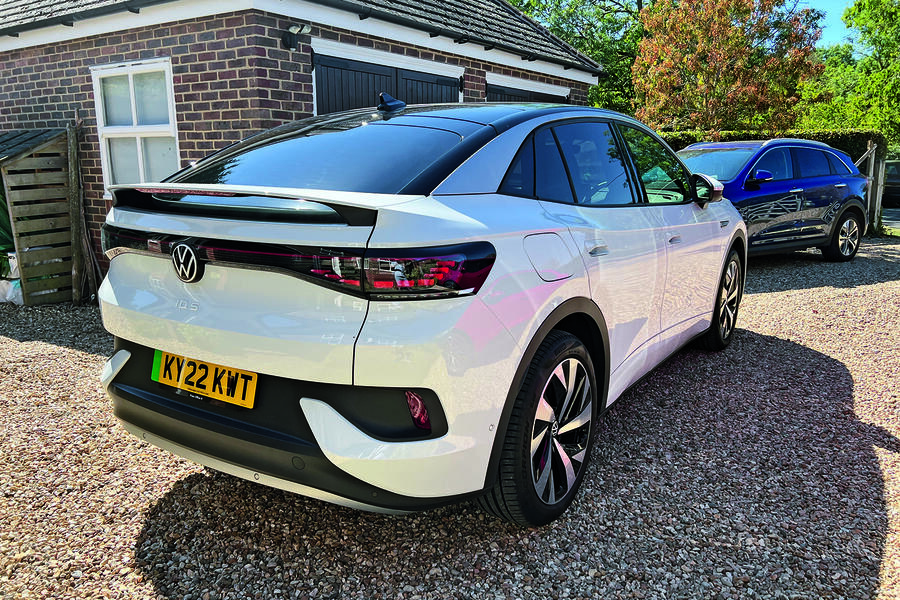
Some areas have improved, yes, but scrolling from page to page is still a tedious affair and latency issues remain present. The Hello ID voice control, meanwhile, is a bit more accurate when responding to commands.
On the road, things are slightly different. This version of the ID 5 doesn’t have four-wheel drive and feels less planted on the asphalt. It’s also more comfortable than the ID 4 GTX, with a softer ride, which is likely to be down to its 19in wheels (the GTX has a 20in set) and the fact that the GTX has sports suspension.
Despite the boosted comfort of the ID 5, I was left pining for the performance and stability of my GTX. I’m not so much interested in the head-up display (which just shows what’s on the small display behind the steering wheel anyway) or other techy bits – and I even prefer the ID 4’s seats.
In this Tech spec, the ID 5 will also set you back £53,165 (at the time of writing) and the ID 5 GTX will cost you £55,570. Compare this with £51,580 for the ID 4 GTX. I think I would be willing to sacrifice a few extra bits of equipment I won’t use for added performance and save the pennies.
Plus, I have far more use for a rear windscreen wiper on an SUV than a rear spoiler. I’m sure most do.
Love it
Longer Range
The extra range of the ID 5 is very handy, and I can see the appeal of reduced power for more mileage. Not everyone needs the GTX.
Loathe it
Infotainment woes
Despite the 3.0 software update, the latency issues remain. Voice control is better now, but it still interrupts general conversation.
Mileage: 5920
A settings switch-up provides the best drive - 31 August
After weeks of tinkering, I’ve settled on my preferred driver settings. The ID 4 feels best on the road when the chassis is in Comfort mode, but setting the steering to Sport adds a nice weighty feel. Despite the GTX being a performance model, I’ve settled for Eco driving mode for those welcome extra miles
Mileage: 5839
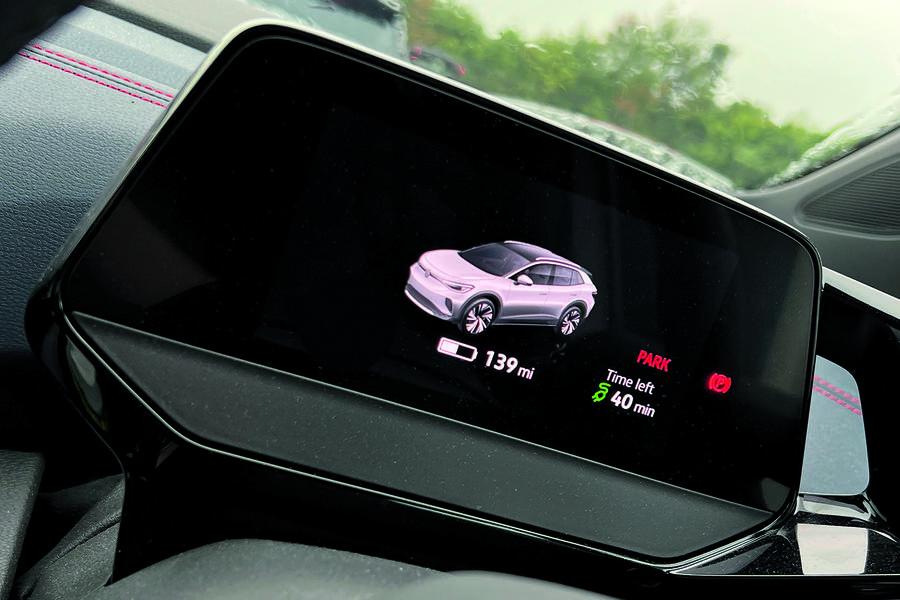
Love it
LED matrix headlights
Simply the best headlights I’ve ever used, with intelligent adaptive features. Full beam also opens like cinema curtains.
Loathe it
Driver's display
There’s a lot of wasted space on the driver’s display behind the steering wheel, unless you’re using the built-in sat-nav (I rarely do).
Mileage: 5221
Warm weather means more miles - 17 August
Mileage: 4742
Our driver much prefers buttons to touchpads - 3 August
I can’t fathom why Volkswagen thought it would be a good idea to swap four window switches for two switches and a touchpad to alternate between the front and rear windows. Not only did it take me an age simply to work out how to use it, but it’s not at all responsive to your inputs and it takes your eyes off the road.
Mileage: 4312
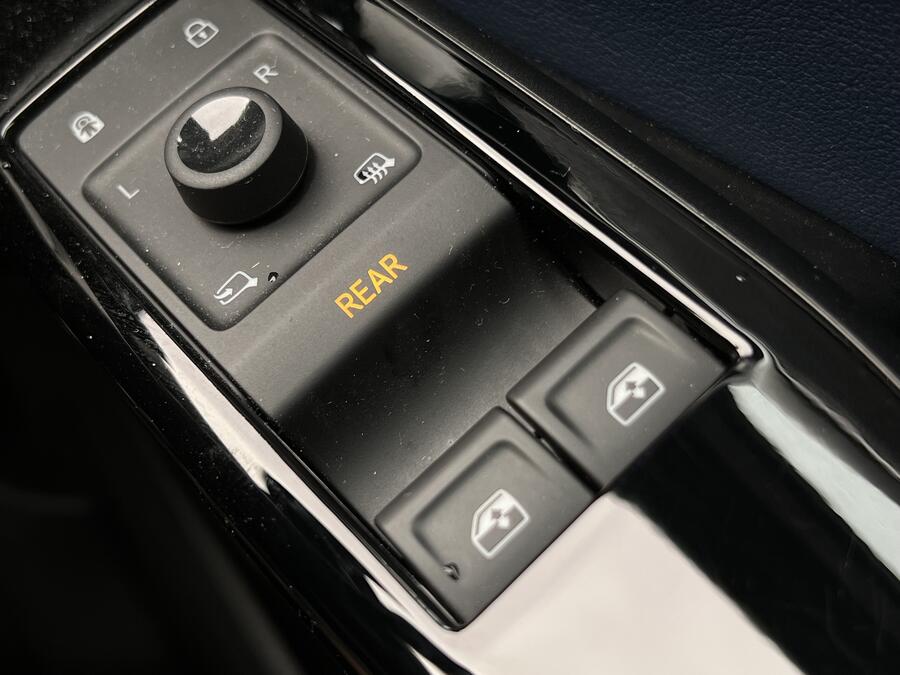
Stop the presses: my family actually likes a car I’ve brought home! This truly is a revelation. With my previous long-term test cars, they have variously complained about a shortage of lleg room in the back and stingy boot capacities, and have even shared their disappointment about the lack of sizeable storage bins.
It’s all smiles this time, because the ID 4 is brilliantly packaged and great in terms of practicality. Let’s start with the boot. The GTX’s measures 543 litres and has plenty of room for several suitcases (nine carry-ons under the parcel shelf, according to our friends at What Car?), a full family shop or a worthwhile trip to the tip.
The ID 4 scores additional points thanks to the shape of its rear end. It’s more of a traditional SUV shape, unlike the closely related, coupeÃ- inspired ID 5, with an angular back end designed to improve aerodynamics.
In my experience, a sloped rear isn’t ideal for pets, but our Lab is right at home in the ID 4. There’s also an adjustable boot floor and space for charging cables beneath it so they’re not flying around back there.

Leg room is also generous, to the extent that even my grandparents paid their compliments during a recent trip to the pub. That’s no doubt helped by the car’s 4584mm length, which is slightly shorter than a Ford Mustang Mach-E (4713mm), but it offers comparable space in the rear.
I’m also making good use of the numerous storage spaces around the car, such as the door bins, which are large enough for a 1.5-litre bottle of water and particularly useful during thermometer-busting heatwaves.
Rear passengers also have access to pockets on the back of the front seats, which are handy for tactically planting the latest issue of Autocar.
And you can be sure that filling the ID 4 to the brim will not hamper its performance. The powertrain is so far certainly helping the car live up to its “as sporty as a GTI billing”. Power is instant and acceleration smooth, and the GTX’s 295bhp and 6.2sec 0-62mph time are, dare I say it, making the GTX actually quite good fun to drive.
It’s well capable of shocking neighbouring motorists at a set of traffic lights or briskly overtaking a sluggish A-road driver. No matter your view on what a GTX should be, or how much performance cars bearing the badge should have at their disposal, the average driver will never want for sufficient power.
Having made my peace with various software-related issues experienced early on in my stewardship, the GTX is growing on me. Its range, performance and practicality have so far shown it has the potential to be a genuinely dependable family hauler.
Love it
Driving Pedals
The ‘play’ and ‘pause’ design of the driving pedals is good fun and adds to the overall digital feel of the car.
Loathe it
Glossy plastics
The interior ambience is spoiled slightly by the abundance of cheap- looking, shiny plastics, which are a magnet for dust and fingerprints.
Mileage: 3561
Back to the top
We’re enjoying our honeymoon, although we’ve had a few disagreements already - 20 July
I'm not usually one to bother with remote vehicle functions, but I recently spent a short while setting up Volkswagen’s We Connect smartphone app.
It wasn’t the easiest of processes. I started by downloading the app onto my iPhone, setting up my profile and trying to register the car.
As well as a few connection issues, there was another slight problem here: the car has to be reset to factory settings before you can set up a new ‘primary account’ if one is already registered.
That won’t be a problem for buyers who have just picked up their shiny new electric Volkswagen, but because this is a pre-used press car, it was a problem for me.
As a result, I lost my individual driving mode settings, my favourite radio stations and, importantly, my personally adapted lane-keeping assistance settings and my saved sat-nav destinations. It took a good hour of fumbling my way through the ID 4’s confusing touchscreen infotainment system before I was content that everything was back to how it was before.

Now that I’m set up, I can see the car’s current level of charge remotely and manually turn on and schedule the air conditioning – a useful feature for the muggy months we’re now into. I’ve also chosen a preferred service partner and can request roadside assistance at the click of a button.
The best feature, though, is the map, which displays every public charger in the local area. They are colour coded to show those that are available, in use or fast-charge-compatible. It will no doubt come in handy on longer trips, when I’m out of reach of my home charger.
That said, the ID 4’s range is one of its best qualities, especially with temperatures on the rise. I’ve not yet seen the official range figure of 301 miles borne out, but the 279-mile high recorded so far is exemplary in my experience with electric cars. Unlike in my previous long-termer, a Lexus UX 300e, I never suffer range anxiety, which is also
partly down to the ID 4’s relaxing atmosphere. It rides exceptionally well despite its 20in wheels, ironing out smaller bumps and making light work of most larger potholes.
The seats are also comfy, with lots of scope for adjustment (although I reckon they should be electronically controlled, given that this car costs more than £50,000).
It’s also quiet. The powertrain does emit a light electrified squeal when you really put your foot down, but otherwise it’s almost silent and actually quite serene.
Road and wind noise are both at a minimum, and the only sort of rattle comes from either my water bottle in the door’s storage compartment or from the two loose footballs that I’ve lazily chucked into the boot.
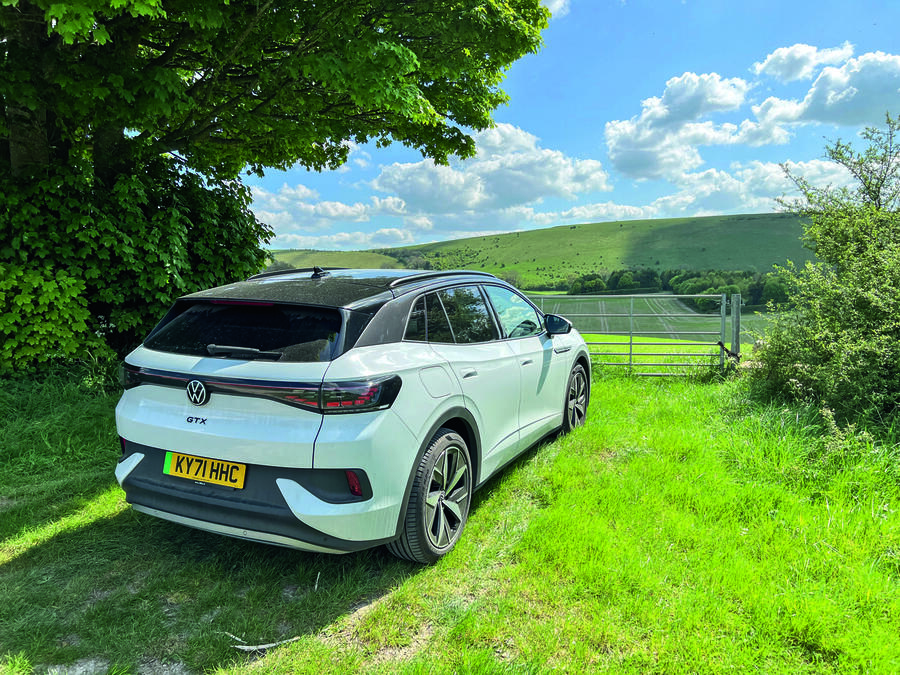
The switchgear is of a peculiar design, though. Perhaps this is my fault, but I’ve shifted into drive rather than reverse more times than I would like to admit, particularly when attempting to park quickly or make a three-point turn.
Indeed, the ID 4 isn’t short of finicky controls. Touchpads are everywhere, controlling all the major functions on the steering wheel, the opening of windows and the car’s exterior lights. They’re difficult to use and not particularly responsive, either: I often have to tap two or three times before they accept a command.
The most difficult things, though, are the temperature controls. They’re not lit, meaning they’re nigh-on impossible to use at night. They’re also incredibly distracting to use: I really need to concentrate to get them to do what I want, which is far from ideal when I’m trying to focus on safely guiding a two-tonne hunk of metal, especially at high speeds.
I understand why there’s a trend of replacing buttons with touchpads in cars. They cut down on parts, they’re no doubt cheaper and sometimes they look sleek and reduce cabin clutter. But a lot of the time, they just don’t work – and safety should surely always take priority over style, too.
Love it
Easy rider
It’s finely balanced and composed, soaking up most bumps without being too soft or bouncy.
Loathe it
Lost in translation
The voice assistant has limited functions and rarely understands simple requests. It’s good for finding a nearby Nando’s, though
Mileage: 2984
Rise of the robots? This car certainly seems to have a mind of its own at times - 13 July
There are some things about our ID 4 GTX that really make me think it's alive.
For example, when I unlock it, its LED matrix headlights move around creepily like giant eyeballs. And when I get out of it, it emits the trademark Volkswagen noise that almost makes it seem like the car is saying goodbye to its driver.
One way that technology has been used to good effect is when the built-in sat-nav works together with the interior ID Light function to point me in the right direction when I approach a junction.
It isn’t all perfect, though. As much as I would be all for a car version of Disney’s Baymax in real life, some of the ID 4’s systems are irritating at best. Of course, I’m talking about the advanced driver assistance systems (ADAS), which include lane keeping assistance, automatic emergency braking, swerve support and adaptive cruise control.

In fairness, the ACC is mostly very good, save for one strange quirk that I encounter frequently, but only ever on the M3 just before Thorpe Park. The car will recognise that a bend is coming up ahead and then slow itself down to 50mph.
This particular bend is nothing more than a slight curve in the motorway over a mile or so, for which you barely even need to turn the steering wheel. The drivers behind me must have been just as confused as I was when the ID 4 assertively reduced its speed from 70mph to 53mph without warning.
Another ADAS blemish is that it annoyingly doesn’t include blindspot monitoring on the car’s mirrors as standard, which it really should do at this price. The omission means it can be difficult to see if any vehicles are overtaking (or undertaking) me on the motorway, given the length of the car and the A-pillar hampering visibility.
My main gripe, though, is with the lane-keeping assistance. It may be effective on motorways, but on smaller roads you almost have to wrestle with it. Country roads are a particular chore, as the ID 4 will twitch and jerk, often confused as to whether I’m driving too close to the side of the road or too close to the centre of the lane.
The constant bonging and the “stay in the middle of the lane” and “take control of the steering wheel” messages appearing on the dashboard are frustrating when I’m not doing much wrong.
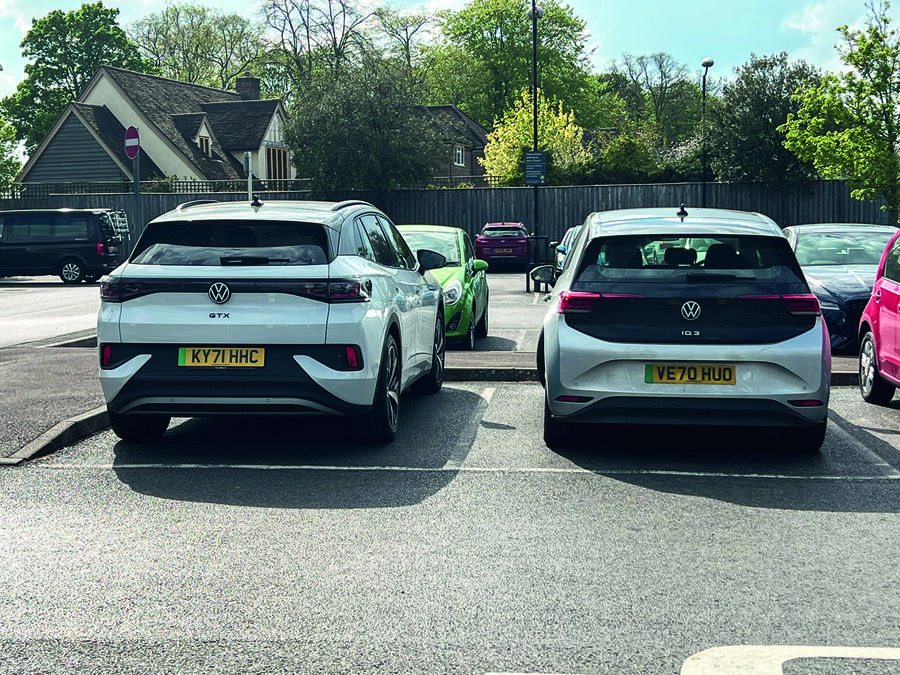
I wouldn’t quite call it a robot uprising, but it’s often curse-inducing, especially when I have to yank the wheel to get back on the correct side of the road.
I am keen on the ID 4’s parking assistance, at least. This is quite a big car, and it certainly feels lit when I'm driving down a country road or squirreling around a multi-storey car park. The reversing camera, included as standard, is clear and the automatic emergency braking saved my bacon in one particularly tight space.
All of this should be made much easier when I find time to fully test the Park Assist Plus system, which is also fitted at no extra cost. This uses data collected from the ‘swarm’ of similarly equipped cars out there to search for vacant spaces nearby and will then automatically slot you into one by controlling the steering, acceleration and braking. It can also help out if you muck up your reversing manoeuvre.
Some automated systems in modern cars are great, but others clearly need more fine-tuning. Volkswagen plans to roll out its first self-driving technology in 2025, and will no doubt be busy perfecting these systems and far more advanced ones in the years ahead.
Love it
Acceleration
With 295bhp, the GTX is fantastic at overtaking on the motorway, and acceleration from a standstill is instant but not jolting.
Loathe it
Radio headache
It can be a pain to select the station I want to listen to as navigating the touchscreen isn’t straightforward. The steering wheel’s touchpads aren’t much cop, either.
Mileage: 2133
Bug-splattered EV is difficult to keep clean - 29 June
This warmer summer weather has made the ID 4’s big, wide front end a magnet for insects. I normally wouldn’t mind too much, but they really show up on this bright-white paint. And it does make me feel guilty, given insect numbers across the UK have plummeted by 60% over the past 20 years. No doubt they didn’t hear the EV coming.
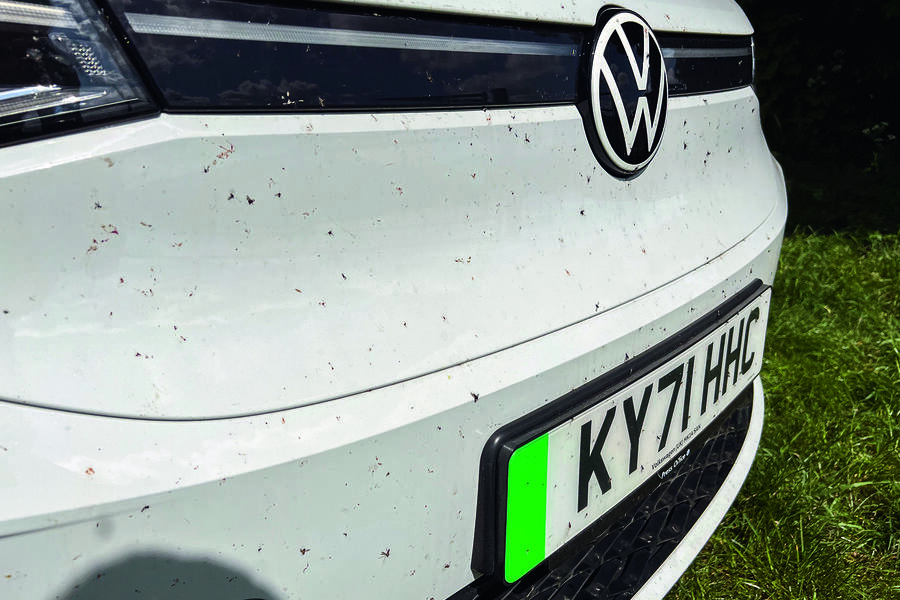
A ghostly apparition on the ID 4's radar - 22 June
Volkswagen’s radar system is more useful than some because it shows you the type of vehicle in front of you and how close it is to the front of your bonnet (although doesn’t the windscreen already do that job?). It does seem to believe in ghosts, though. I parked in my driveway one evening and it displayed a spooky phantom motorcyclist. It hasn’t been seen since...
Mileage: 334
Life with a Volkswagen ID 4 GTX: Month 1
Welcoming the ID 4 GTX to the fleet - 15 June 2022
On the surface, the ID 4 has everything you would need from an all-electric crossover: a decent, usable range, a suite of interior technology, a potent powertrain and a particularly spacious interior.
There’s also another reason for my enthusiasm – and it comes in the form of three letters on the car’s boot: GTX. Is this Volkswagen finally flexing its muscles in the performance EV sector by showing us how it’s going to replace the GTI once we move to electric-only power?
Well, not quite. Volkswagen says the GTX is not, in fact, a GTI. Instead, the firm insists the badge represents the addition of four-wheel drive as well as a vast amount of equipment as standard. While GTI models are more for enthusiast drivers, the GTX range is intended for grand touring purposes, with punchy performance an added benefit.
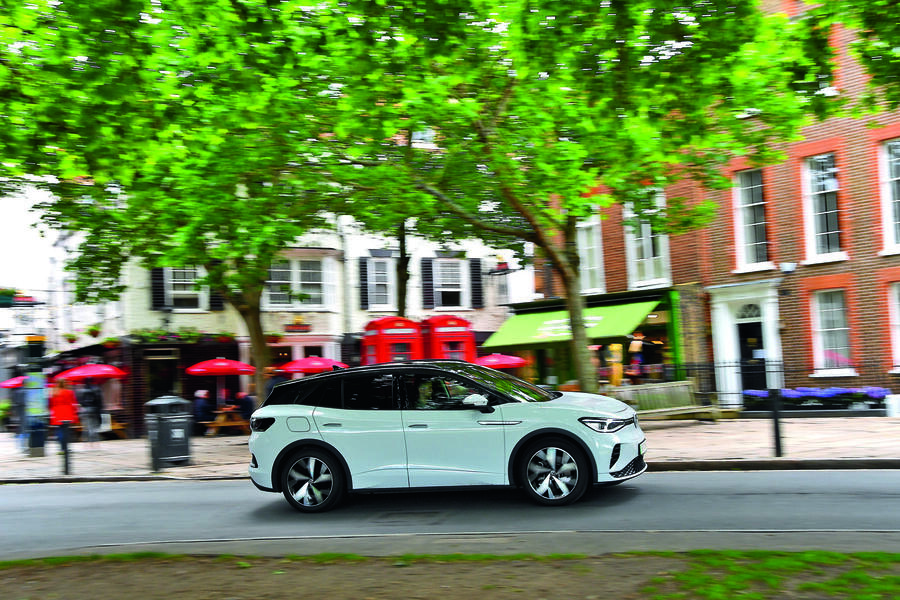
The key changes from the regular ID 4 come under the skin. A second electric motor has been added, located at the front axle, for a total power output of 295bhp and 348lb ft of torque. That’s good for 0-62mph in 6.2sec officially – not slow by any means, but outpaced by the Tesla Model Y I tested in February, which completes the sprint in 5.0sec, and far down on the 3.5sec claimed for the Kia EV6 GT.
There aren’t many visual differences between the standard ID 4 and the GTX. Our car is painted in Glacier White (a £685 option), but a layman probably couldn’t tell the difference between the two on the road, until they clocked the ‘GTX’ badging on the centre of the tailgate.
The other changes include black air intake grilles, a black roof, a bespoke rear spoiler and anthracite roof bars. The model also has its own LED configuration: the lights at the back of the car are designed to illuminate in an X-shape, in combination with the rear light bar.
The GTX sits 15mm lower than the regular car, too, and has an XDS electronic differential lock and a new Vehicle Dynamics Manager. The specification above this car’s – the GTX Max – adds other gubbins such as Dynamic Chassis Control dampers.
Standard kit also includes a host of assistance tech, Volkswagen’s clever IQ Light technology, a rear-view camera with park assist, keyless entry, wireless phone charging and wireless Apple CarPlay.
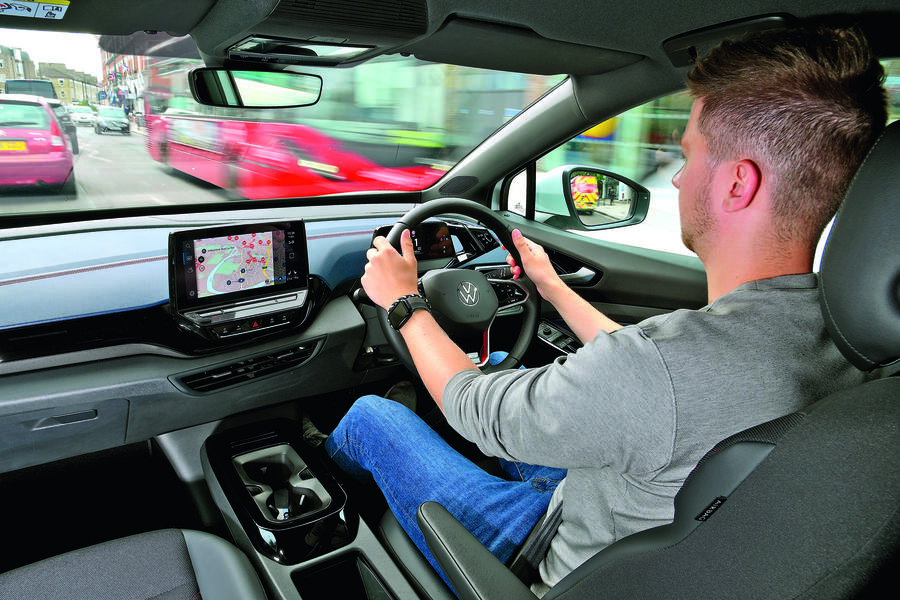
There’s Volkswagen’s new infotainment system, too. Ours is the larger, 12.0in unit, which is graphically crisp but functionally frustrating. It’s the centrepiece of an otherwise fairly barren interior, with all the functions controlled through touchpads and haptic sliders – the latter of which are still not lit, so you can’t use them after dark.
The interior tech hasn’t received the best response from many testers, so it will be interesting to see how I take to it given my lack of patience, particularly with the new ID 3.0 software, which is said to resolve the latency issues that have plagued the system since the launch of the ID 3.
It’s a fairly comprehensive package, but there are some drawbacks to all this extra gear. The GTX is heavier than the standard car, at 2149kg, and its range drops slightly compared with that of the regular car as a result.
The EV’s energy is supplied by Volkswagen’s biggest battery on the market – an 82kWh pack with a usable capacity of 77kWh. On lower- spec, less performance-oriented cars, it can achieve up to 322 miles of range, but that drops on the GTX to 301 miles. Still, it’s a respectable figure that I’m seriously looking forward to taking advantage of on my long work commute.
Having made the journey in the GTX a few times already, I’ve managed to nurse it home with enough charge to do the same trip again the next day, no doubt helped by the warmer weather of early summer.
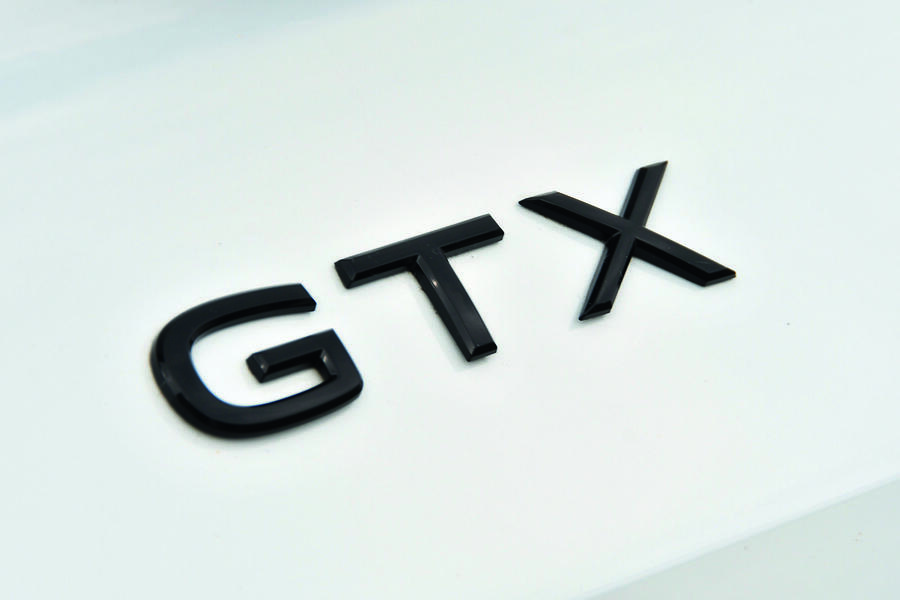
Charging from empty through a 7kW home charger takes around 12 hours and 40 minutes (the car can charge at a maximum of 125kW), although the range of the GTX is so comprehensive that I doubt I’ll ever need to consider charging for that long. And with that, I’ve no doubt jinxed it.
Another area where the ID 4 scores some bonus points is practicality, which will no doubt be a key criterion for many prospective buyers. There’s a 60/40 split in the back seat and the boot space is a Labrador-friendly 543 litres. That’s just behind the 585 litres offered by the technically similar Skoda Enyaq iV but much bigger than the Ford Mustang Mach-E’s 402 litres.
So far, I’m confident in the range, the performance and the space in the back, but will my ownership experience be sullied by software snags? Watch this space.
Second Opinion
Not an easy task, making a two-point-something- tonne battery SUV engaging to drive, but Kia managed it. So has Ford, and Jaguar cracked the code a few years back. So the numbness of the ID 4’s helm does jar, slightly, given the GTX badge was always meant to be an indicator of ‘sportier’ innards. It is mighty relaxing at a cruise, though, which combined with a long range should make it very easy to live with.
Felix Page
Volkswagen ID 4 GTX specification
Prices: List price new £50,540 List price now £52,730 Price as tested £53,265
Options: Energy-efficient heat pump £1050, Glacier White metallic paint £690
Fuel consumption and range: Official range 299 miles Battery 82/77kWh (total/usable) Test average 260 miles (3.4mpkWh) Test best 282 miles (3.7mpkWh) Test worst 229 miles (3.0mpkWh)
Tech highlights: 0-62mph 6.2sec Top speed 112mph Engine Asynchronous motor (f), permanently excited synchronous motor (r) Max power 294bhp Max torque 348lb ft Boot capacity 543 litres Wheels 8Jx20in (f), 9Jx20in (r) Tyres 235/50 R20 (f), 255/45 R20 (r) Kerb weight 2224kg
Service and running costs: Contract hire rate £880pcm CO2 0g/km Service costs None Other costs None Electricity costs £502 Running costs inc fuel £520 Cost per mile 4 pence Faults Sheared wheel-arch trim clips

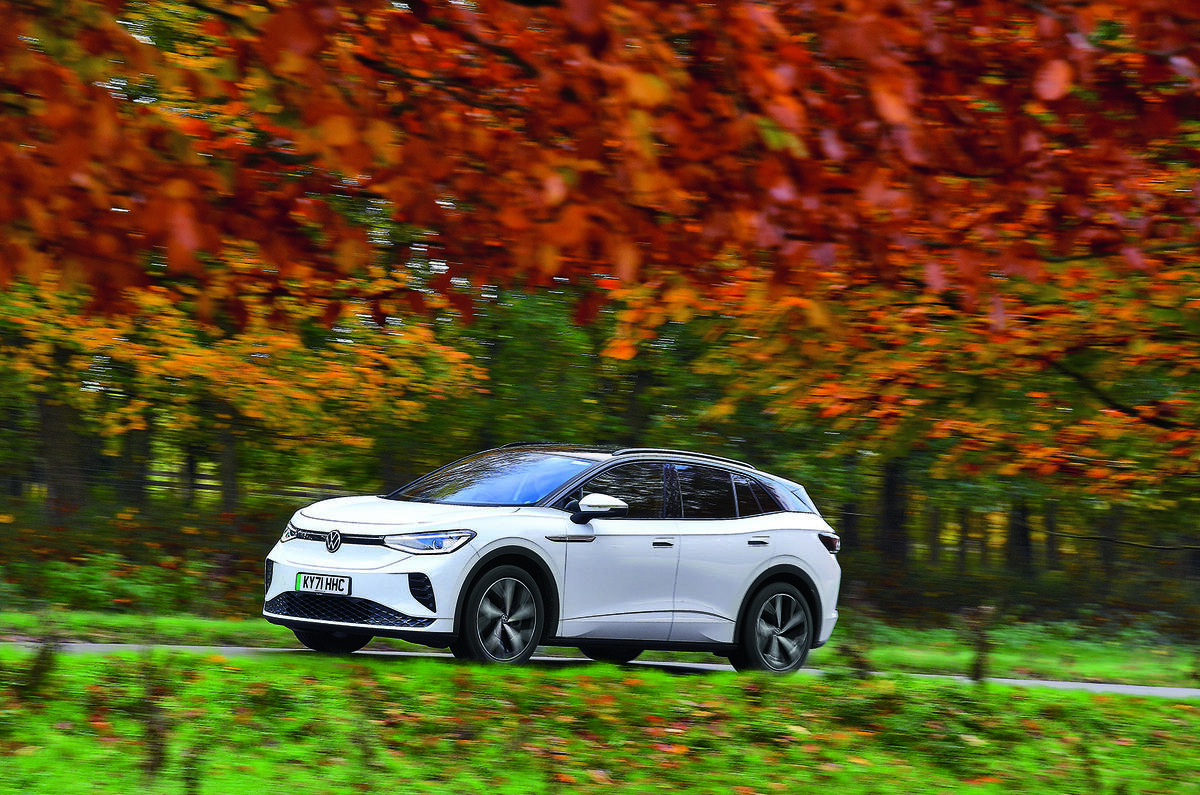
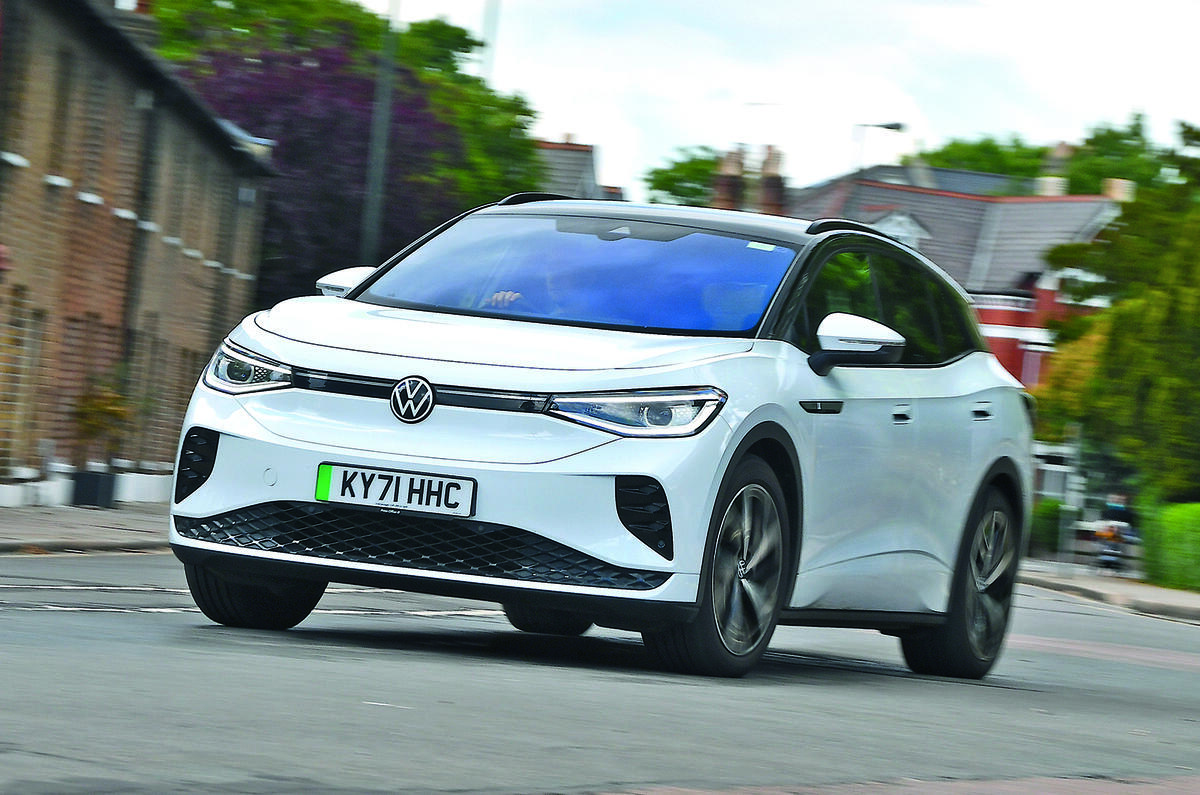
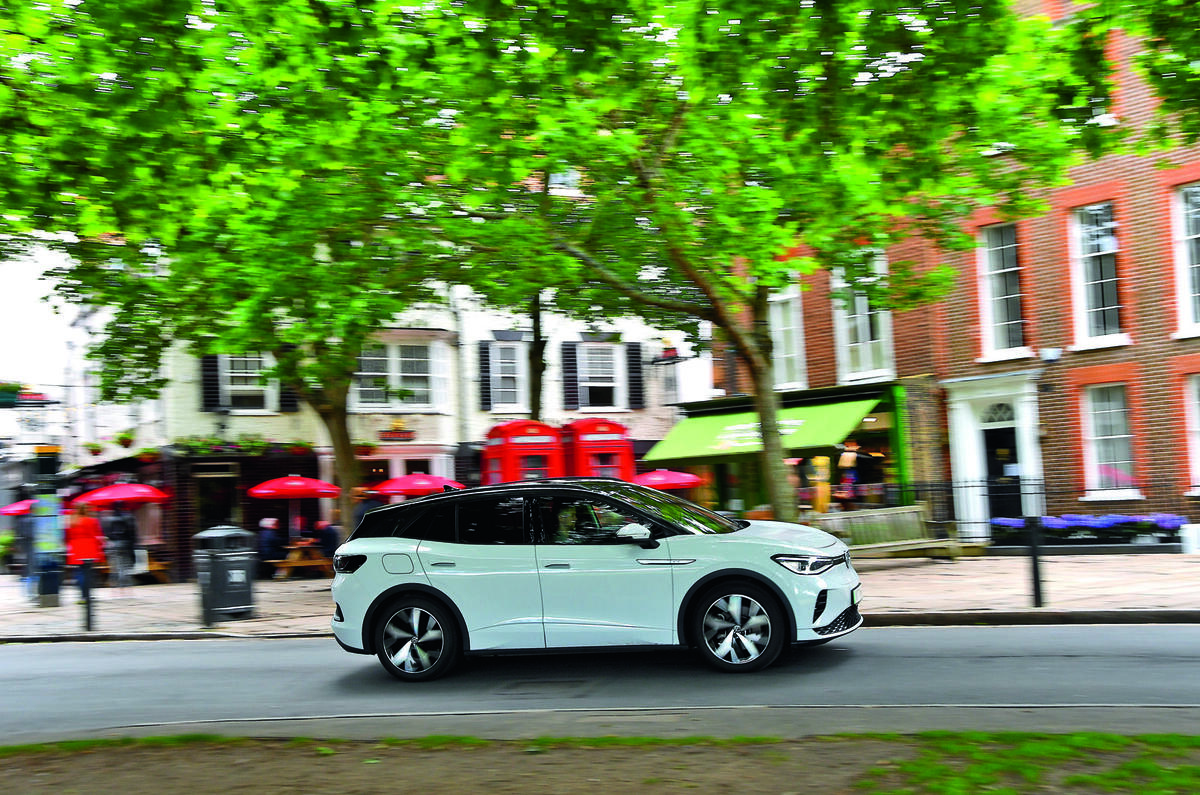
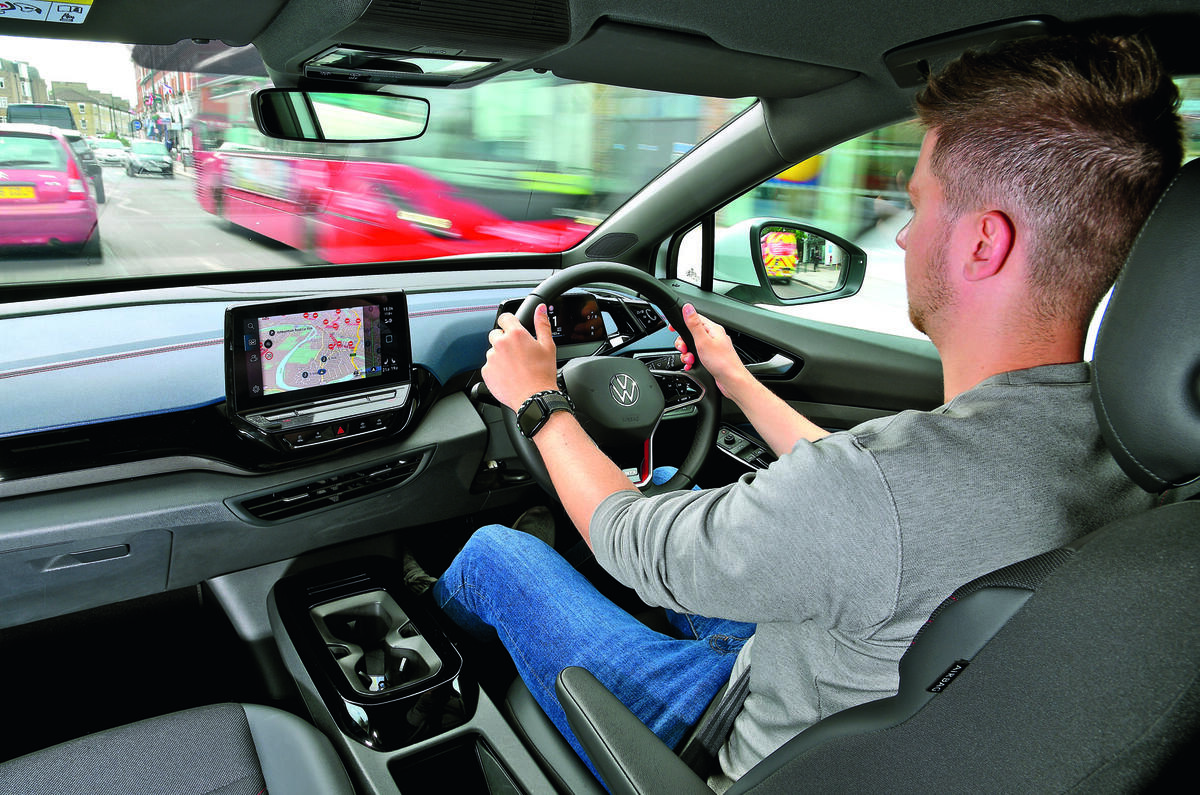
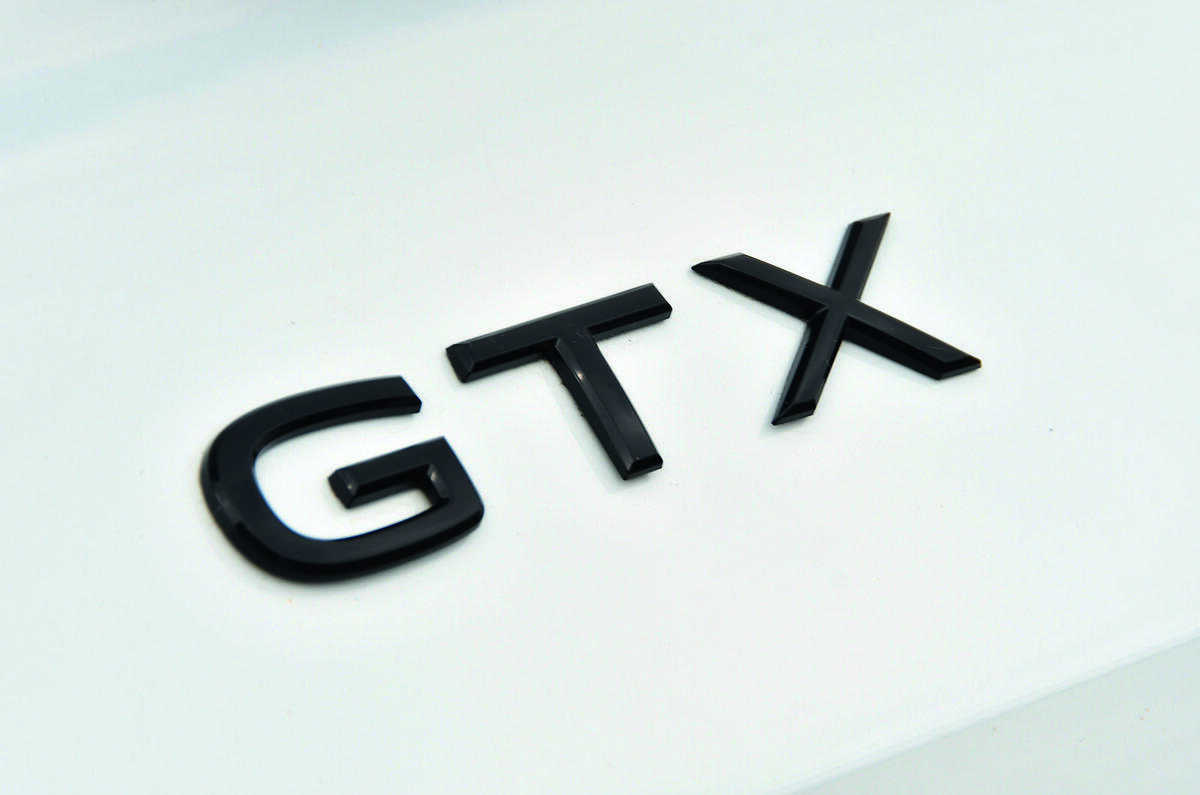

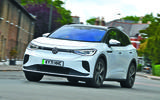

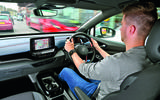


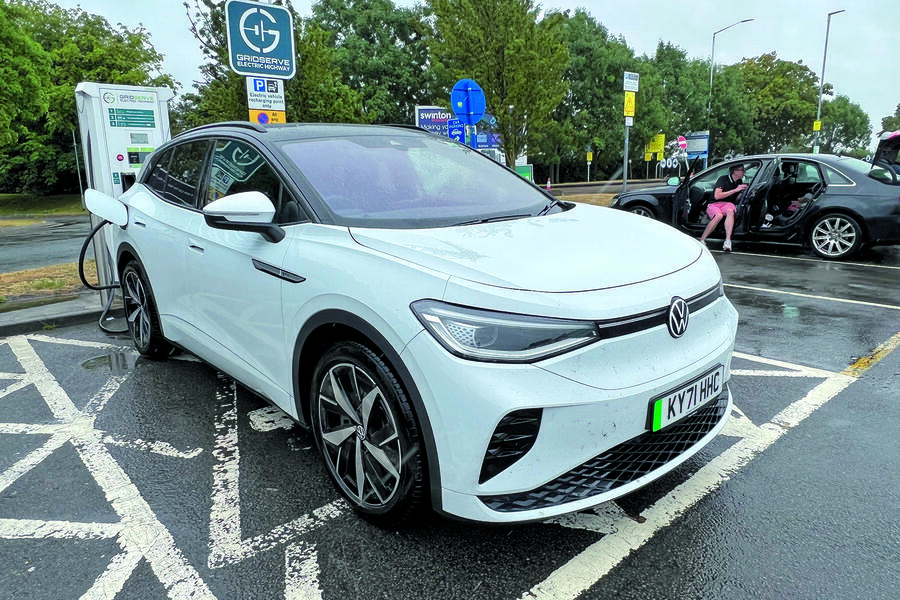

Join the debate
Add your comment
I am making a real GOOD MONEY ($550 to $750 / hr) online from my laptop. Last month I GOT chek of nearly 85000$, this online work is simple and straightforward, don’t have to go OFFICE, Its home online job. b50 You become independent after joining this JOB. I really thanks to my FRIEND who refer me this SITE…..,
>>>>>>> Earncash7.com
"The jury’s still out on VW’s GTX sub-brand ..."
I don't think it is, not according to Autocar's report the other day on the future of the GTi nameplate.
I'm not anti-EV, despite not thinking they are the perfect alternative to ICE cars, but all that torque/perfomance, weight and the easiness of stop / start non-manual gearbox driving is certainly highlighting a lot more dangerous / rubbish drivers out there.